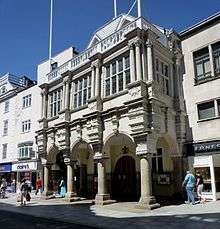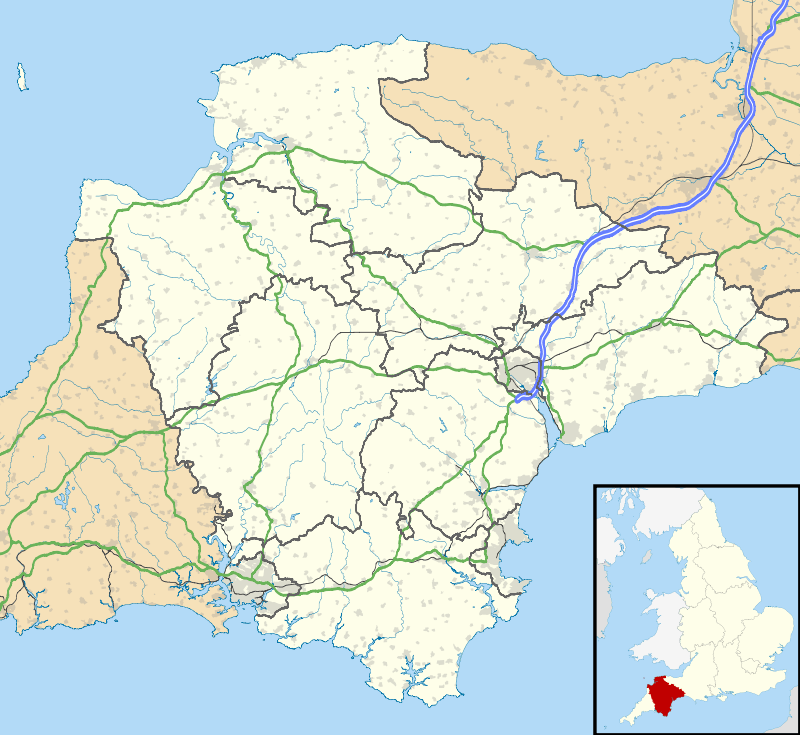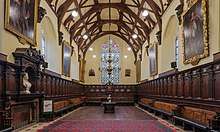Exeter Guildhall
Exeter Guildhall on the High Street of Exeter, Devon, England has been the centre of civic government for the city for at least 600 years. Much of the fabric of the building is medieval, though the elaborate frontage was added in the 1590s and the interior was extensively restored in the 19th century. It is a Grade I listed building.[1]
| Exeter Guildhall | |
|---|---|
 | |
| Location | Exeter, Devon |
| Coordinates | 50.7233°N 3.5318°W |
| Built | 14th century |
| Architectural style(s) | Ornate Italian style |
Listed Building – Grade I | |
| Designated | 29 January 1953 |
| Reference no. | 1103905 |
 Location of Exeter Guildhall in Devon | |
History

It is certain that the hall has been on its present site since the 14th century,[2] and most probably since the second half of the 12th century.[3] It is also known that there was a guild in Exeter by 1000 AD whose hall was most likely here too.[4] On this basis it has been claimed to be the oldest municipal building in England still in use.[5]
The building was refaced in 1593-6 at a cost of £789[6] in an ornate Italian style that was described by Nikolaus Pevsner as being "as picturesque as it is barbarous".[7] The portico that juts out over the pavement is dated 1594 and its four sturdy granite columns are surmounted by highly decorated corbels of Beer stone. The upper floor, also in Beer stone, is more restrained with strapwork and 16 smaller paired pillars framing large windows that have both mullions and transoms. During renovation work it has been noted that the stonework had once been painted in cream with details in red and blue and the pillars gilded.[2][7]
The city stocks were once under the portico. The elaborately carved oak door, dated 1593, was made by Nicholas Baggett, a local carpenter.[2] It leads via an anteroom to the council chamber which apparently dates to 1468-70,[7] though it was much restored in Victorian times. The arch-braced roof with seven bays is original; its main trusses rest on carved corbels representing grotesque animals.[2][8]
A large chandelier hangs from the centre of the roof. It was made by Thomas Pyke of Bridgwater and installed in 1789. Apart from this and the roof, all the internal fittings are Victorian, including the stained glass, the gallery, the furniture and the stone floor (all 1863) and the heavily restored Tudor panelling (1887). Above the fireplace is a bust of Queen Victoria by Henry Hugh Armstead.[2]
Under the council chamber there is an early 14th-century cellar. This was once a prison that was known as the "pytt of the Guyldhall". In the 16th century another prison, for women, was built on the ground floor at the back of the building. It remained in use until 1887. In 1858 a room was built above this to store the city's records; it was later used as a jury room.[2]
20th century
The front room above the portico was once a council chamber but since 1903 has been used as the mayor's parlour.[9] It had a plaster ceiling dating to about 1800 that was removed and replaced with a replica in 1986.[2]
In 1911 the chamber was the location for an election petition following the second general election of 1910 between the Liberal candidate Harold St. Maur and the Conservative Henry Duke.[10]
Exeter Guildhall has been a Grade I listed building since 1953 and is also a scheduled ancient monument.[1] According to Exeter City Council it is still used for civil purposes such as official receptions, mayoral banquets, some City Council meetings, other meetings and exhibitions and occasionally as a magistrates' court.[11]
Heraldry
The main chamber displays on the wooden panelling many heraldic escutcheons displaying the arms of various persons who held high office within the City Corporation, covering much of the heraldry of Devonshire. The heraldry was identified in the View of Devonshire by Thomas Westcote (d. circa 1637)[12] and later expanded upon by Colby, Rev. Frederick T., in his The Heraldry of Exeter.[13]
References
- Historic England. "Guildhall, Exeter (1103905)". National Heritage List for England. Retrieved 25 August 2019.
- Meller, Hugh (1989). Exeter Architecture. Chichester: Phillimore. pp. 42–44. ISBN 0-85033-693-7.
- Blaylock 1990, p.123.
- Hoskins 2004, p.24.
- See for example: Hele's School Historical Society. (1947). Exeter—Then and Now. A. Wheaton & Co. p. 31.
- Hoskins 2004, p.70.
- Pevsner, Nikolaus (1989) [1952]. Cherry, Bridget (ed.). The Buildings of England: Devon. Harmondsworth: Penguin Books. p. 402. ISBN 0-14-071050-7.
- "The Hall - Structure". Exeter City Council. Archived from the original on 27 September 2011. Retrieved 10 December 2010.
- Blaylock 1990, pp.128, 146.
- "Exeter Election Petition". Retrieved 25 August 2019.
- "Introduction". Exeter City Council. Archived from the original on 27 September 2011. Retrieved 10 December 2010.
- View of Devonshire, Chap. XV
- Colby, Rev. Frederick T (1873). "The Heraldry of Exeter". Archaeological Journal. 30: 235–263. doi:10.1080/00665983.1873.10851599.
Sources
- Blaylock, S. R. (1990), "Exeter Guildhall", Devon Archaeological Society Proceedings, 48: 123–178, ISSN 0305-5795
- Hoskins, W. G. (2004). Two Thousand Years in Exeter (Revised and updated ed.). Chichester: Phillimore. ISBN 1-86077-303-6.
Further reading
![]()
- Cornforth, David. "History of the Guildhall". Exeter Memories. Archived from the original on 21 November 2010. Retrieved 10 December 2010.